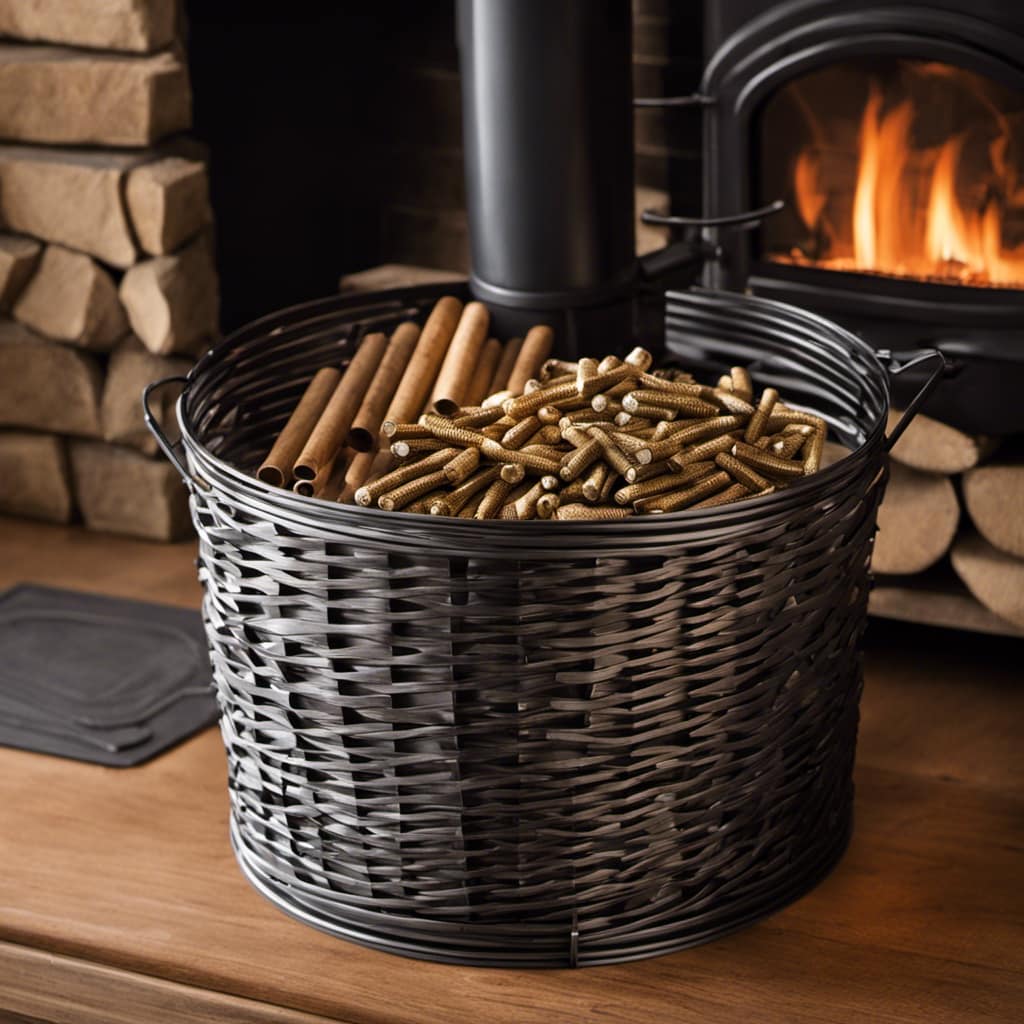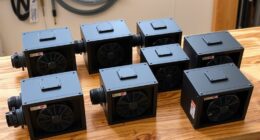To extend your wood stove's life, focus on proper care and maintenance. Start by scheduling annual chimney sweeps to prevent creosote buildup, which can lead to fires. Use dry, seasoned wood with less than 20% moisture for better combustion and less smoke. Avoid overloading your stove to prevent overheating and inspect door seals regularly to guarantee proper airflow. Keep a log of your inspections and maintenance tasks. Finally, follow manufacturer guidelines for cleaning and operation. With these steps, you can greatly increase your stove's longevity while enjoying its warmth, and there's plenty more helpful information to explore.
Key Takeaways
- Schedule annual chimney sweeps to prevent creosote buildup and reduce fire risks associated with wood stoves.
- Use high-quality, seasoned hardwoods with moisture content below 20% for efficient combustion and reduced creosote production.
- Regularly inspect and maintain door seals to prevent air leaks and ensure efficient operation.
- Avoid overloading the stove to prevent overheating and prolong its lifespan through proper loading practices.
- Keep a maintenance log to track inspections and cleaning, ensuring consistent care for your wood stove.
Main Causes of Degradation
When it comes to extending the life of your wood stove, understanding the main causes of degradation is fundamental. One significant factor is creosote buildup, which results from incomplete combustion. This tar-like substance can obstruct airflow, increasing the risk of chimney fires if you don't manage it through regular cleaning.
It's essential to guarantee that you burn dry, seasoned firewood to minimize excess smoke and creosote production. Burning wet wood not only produces more creosote but also leads to inefficient combustion, damaging your stove components and reducing overall efficiency. Additionally, improper disposal practices can lead to increased maintenance needs, similar to how clogging remedies are necessary for toilet issues.
Continuous use of your wood stove causes wear and tear, making stove maintenance critical. If you neglect routine inspections and cleaning, you accelerate degradation and compromise your stove's safety and efficiency.
Additionally, overheating can occur if you don't follow proper operating guidelines, damaging the materials of your stove and shortening its lifespan. By being aware of these causes, you'll empower yourself to take the necessary steps to prolong the life of your wood stove.
Prioritizing regular maintenance and understanding the consequences of poor practices can keep your stove running smoothly for years to come.
Essential Maintenance Tips

To keep your wood stove running effectively and safely, regular maintenance is key. Start by scheduling a chimney sweep at least once a year. This prevents creosote buildup, a fire hazard that can also reduce your stove's efficiency.
Always use dry, seasoned wood with a moisture content below 20%. This not only enhances combustion but also minimizes damage to stove components. Additionally, consider using a high-efficiency stove, like the Englander 10-Cpm, which generates up to 50,000 BTUs and can greatly improve your heating experience.
Avoid overloading your wood stove; excessive fuel can lead to overheating and shorten its lifespan. Regularly inspect door seals—you can perform the paper test to check for air leaks. If the paper pulls out easily, it's time to replace the seals for peak performance.
Additionally, follow your manufacturer's maintenance guidelines closely. Clean out ash pans and lubricate any moving parts as recommended.
Safe Operation Practices

Proper maintenance is just the start; safe operation practices are equally important for maximizing your wood stove's lifespan. Always adhere to the manufacturer's operating guidelines. This guarantees safe and efficient performance, minimizing the risks of malfunction or danger.
Additionally, implementing key factors in choosing a home cleaning service can help guarantee your living space remains safe and clean, which complements the overall safety of operating your wood stove. Avoid operating your stove during adverse weather conditions or excessive usage, as these can lead to unsafe situations and reduce its longevity.
Regularly monitor the stove's temperature to prevent overheating. High temperatures can damage components and shorten its service life. Using good quality wood is essential, too; it burns cleaner and reduces creosote buildup, which can create fire hazards.
When your stove isn't in use, invest in protective covers. They shield your stove from weather-related degradation, maintaining its integrity and functionality.
It's also vital to conduct routine inspections. Make it a habit to inspect your stove for wear and functionality, identifying potential issues before they escalate into serious problems.
Installation Considerations

When installing your wood stove, choosing a safe location is key to avoiding hazards.
To guarantee ideal air quality and efficiency, consider utilizing ozone air purifiers to minimize allergens and odors in your home.
You also need to guarantee proper ventilation to keep your home safe and efficient.
Hiring a qualified professional for the installation can help you meet all safety standards and maximize your stove's performance.
Safe Location Selection
Choosing the right location for your wood stove is fundamental for safety and efficiency. Start by ensuring it's at least 36 inches away from combustible materials like furniture, curtains, or wood walls. This minimum clearance minimizes fire hazards and keeps your home safe.
Additionally, it's important to be aware of any environmental factors that could impact the stove's performance, such as ensuring the area is free from strong odors that might interfere with air quality, similar to how 10 smells cats hate can deter felines.
Next, consider where you'll place the stove. A well-ventilated area is essential, as it promotes efficient combustion and reduces smoke buildup inside your home. If your stove is near walls or furniture, think about installing a heat shield to protect these surfaces from heat damage.
Make sure to install your stove on a non-combustible surface, such as tile or concrete, to further reduce fire risks and comply with safety standards.
Additionally, assess the proximity to a chimney or flue; this is critical for ensuring proper venting and airflow. Proper venting is necessary for ideal stove performance and safety, so don't overlook this aspect.
Ventilation Requirements Importance
How can you guarantee your wood stove operates efficiently and safely? One key factor is adhering to proper ventilation requirements. Adequate ventilation is essential for efficient combustion, providing the necessary air supply for a clean burn. Without it, you risk incomplete combustion, which not only reduces heat output but also increases creosote buildup in your chimney. This accumulation can lead to serious safety hazards, including chimney fires.
Additionally, understanding the role of geothermal energy basics in enhancing heating solutions can further improve your overall heating strategy.
Moreover, proper ventilation limits smoke buildup inside your home, which helps maintain better indoor air quality and reduces the risk of carbon monoxide exposure—an invisible but deadly gas. By following local building codes regarding ventilation, you guarantee that your installation is compliant and safe, promoting ideal stove performance.
A well-ventilated wood stove not only enhances efficiency but can also save you money on fuel costs. Plus, it can extend the lifespan of your stove components by reducing wear and tear.
Professional Installation Benefits
Investing in professional installation for your wood stove brings a level of assurance that DIY efforts often can't match. Qualified installers guarantee compliance with local building codes and regulations, greatly reducing the risk of safety hazards and legal issues.
They can assess the best location for your stove, optimizing performance by factoring in ventilation and heat distribution. Additionally, proper installation includes safety features that enhance your wood stove's efficiency, similar to how garage door openers maximize home security.
Engaging professionals minimizes the chances of improper setup, which can lead to problems like poor combustion efficiency or increased creosote buildup. Their expertise allows them to recommend the right type of stove and installation techniques tailored to your home's specific layout and heating needs.
A properly installed wood stove not only operates efficiently from the start but also helps enhance longevity by reducing wear and tear on vital components. When everything is set up correctly, your stove is less likely to encounter issues down the line, saving you time and money on repairs.
In short, opting for professional installation isn't just about convenience; it's a vital step in guaranteeing your wood stove performs well and lasts for years to come.
Regular Cleaning Procedures

To keep your wood stove running efficiently, regular cleaning is essential.
You need to manage ash daily, clean the glass periodically, and schedule annual flue maintenance.
Additionally, ensuring proper ventilation during use is vital for safety and efficiency, especially if you're using gas appliances alongside your wood stove safety precautions necessary.
These simple steps will enhance performance and extend the life of your stove.
Daily Ash Management
Regularly managing ash is essential for keeping your wood stove functioning efficiently and safely. After each use, make sure to clear the ash pan to maintain adequate airflow. This airflow is vital for efficient combustion and helps prevent overheating of the stove components.
However, don't remove all the ash; a 1-2 inch layer in the firebox helps insulate the fire and retains heat. Just be cautious not to let it build up excessively, as that can obstruct airflow. Additionally, keeping your stove area clean is important, much like ensuring a healthy environment for your dogs' nutrition.
If your stove lacks an ash pan, use a metal pan and brush for safe manual ash removal, ensuring that the stove is completely cool before you start cleaning. For a more efficient process, consider using an ash vacuum. This can make ash management easier and cleaner, reducing the risk of ash dispersion and keeping your stove area tidy.
Dispose of your ashes in a metal container with a tight-fitting lid, and store it away from flammable materials to prevent fire hazards.
Periodic Glass Cleaning
Keeping the glass door of your wood stove clean is essential for both functionality and enjoyment. Regular cleaning helps remove soot buildup, ensuring you can enjoy the beauty of the fire while maintaining efficient combustion.
To achieve the best results, wait until your stove has completely cooled down before you start cleaning. Using damp newspaper or a cloth dipped in stove ashes to wipe the glass door is effective and gentle on the surface.
Additionally, maintaining proper air circulation around your stove can enhance combustion efficiency and reduce soot accumulation, making cleaning easier. For tips on air circulation techniques, consider exploring methods that optimize your wood stove's performance.
If you encounter stubborn residues, consider using specialized glass cleaners designed specifically for wood-burning stoves. These cleaners can effectively remove tough deposits without damaging the glass.
Annual Flue Maintenance
Annual flue maintenance is a critical step in guaranteeing the safe and efficient operation of your wood stove. Before the heating season kicks off, make certain to schedule a professional chimney sweep to inspect and clean your flue. This thorough check-up helps prevent dangerous creosote buildup, which can ignite and lead to chimney fires.
During the cleaning, the chimney sweep will remove all debris, including soot and creosote, guaranteeing maximum airflow and efficiency of your wood stove.
It's advisable to monitor flue conditions throughout the year, especially if you use your stove more frequently. Increased usage might require additional inspections and cleanings to maintain safety.
To enhance safety between professional cleanings, consider using creosote sweeping logs while burning. These logs can help reduce creosote accumulation and keep your flue in better shape.
Fuel Selection Guidelines

When it comes to maximizing the efficiency of your wood stove, selecting the right fuel is crucial. Following the fuel selection guidelines can greatly enhance your stove's performance and longevity.
Start by choosing seasoned hardwoods like oak, maple, or birch. These types of wood are denser, burn longer, and produce more heat, making them a good stove fuel option.
Be mindful of the moisture content in your firewood; aim for 20% or less. Using a moisture meter can help you assess this effectively.
Avoid burning softwoods like pine, fir, or cedar too often, as they tend to burn faster and create more creosote, which can clog your chimney.
Here are some key points to remember:
- Always opt for dry wood to guarantee ideal combustion.
- Steer clear of non-wood materials like treated wood or plastics, as they can release harmful fumes.
- Source your firewood from reputable suppliers to ensure quality and reduce maintenance issues.
Monitoring and Inspections

Regular monitoring and inspections are essential for maintaining the efficiency and safety of your wood stove. You should conduct these inspections at least once a year to identify potential issues like cracks, creosote buildup, and foreign materials that could lead to hazards or reduce your stove's performance.
During your inspections, check the integrity of flues and stovepipes for blockages and guarantee proper ventilation to maintain ideal combustion conditions.
To effectively monitor your stove's performance, use a wood stove thermometer. Make sure the flue temperature exceeds 250°F to prevent creosote condensation and accumulation. Additionally, inspect the door seals for effectiveness. A simple test involves inserting a piece of paper; if it slides out easily without resistance, the seals may need replacement. This helps prevent air leaks and improves your stove's efficiency.
Keeping a log of inspection dates and findings can be incredibly beneficial. It helps you track maintenance needs and guarantees timely servicing of your wood stove.
Glass Door Maintenance

To keep your wood stove functioning at its finest, maintaining the glass door is crucial. A dirty or damaged glass door not only detracts from your stove's appearance but can also impact its efficiency.
Regular cleaning helps prevent soot buildup and keeps the glass clear for maximum visibility. After your stove has cooled, use damp newspaper or a cloth dipped in stove ashes to wipe down the glass door. For a deeper clean, consider using specialized glass cleaners that are safe for ceramic glass panels.
Here are some quick tips for glass door maintenance:
- Clean regularly to prevent soot buildup and maintain visibility.
- Inspect for cracks frequently to guarantee safe operation and minimize heat loss.
- Avoid cleaning when hot; wait until the glass door has cooled to prevent damage.
Professional Care Recommendations

Maintaining your wood stove goes beyond just caring for the glass door; professional attention is key to its longevity and effectiveness. Schedule annual professional inspections by certified chimney sweeps to catch potential issues early and guarantee you're compliant with local safety codes.
These experts will thoroughly clean the flue and chimney, as accumulated creosote can create significant fire hazards if left unattended.
Engage qualified technicians for any necessary repairs or maintenance, like replacing worn seals or damaged components. This keeps your stove performing at peak performance and helps avoid costly problems down the line.
If you're installing a new wood stove, consider hiring professionals to handle the setup. They'll guarantee proper ventilation and safety compliance from the start, maximizing your stove's effectiveness.
Invest in annual servicing tailored to how often you use your stove. If you use it frequently, you might need more regular maintenance to keep it in prime condition.
Frequently Asked Questions
How Can I Make My Wood Burning Stove Last Longer?
To make your wood burning stove last longer, clean the chimney annually, use dry firewood, avoid overloading, inspect door seals, and follow maintenance guidelines. These steps guarantee efficiency and prevent damage, extending your stove's lifespan.
How Long Will a Good Wood Stove Last?
A good wood stove typically lasts 10 to 20 years, but with proper care, you might see even longer lifespans. Factors like construction materials and maintenance routines greatly influence how long your stove will endure.
What Maintenance Does a Wood Burning Stove Need?
Your wood-burning stove needs regular inspections, annual chimney cleaning, and dry firewood for ideal performance. Check door seals, clean ash pans, and follow the manufacturer's guidelines to maintain efficiency and safety throughout its use.
How Do You Prevent Creosote Buildup in Wood Stoves?
To prevent creosote buildup in your wood stove, burn only seasoned wood, maintain hot fires, clean your chimney yearly, use creosote-reducing products, and keep flue temperatures above 250°F to minimize condensation.
Conclusion
By following these tips, you can greatly extend the life of your wood stove and enjoy its warmth for years to come. Did you know that regular maintenance can reduce the risk of chimney fires by up to 90%? Taking care of your stove not only enhances its efficiency but also keeps your home safe. So, make a habit of cleaning, inspecting, and using the right fuel to guarantee your wood stove remains a reliable source of heat.











